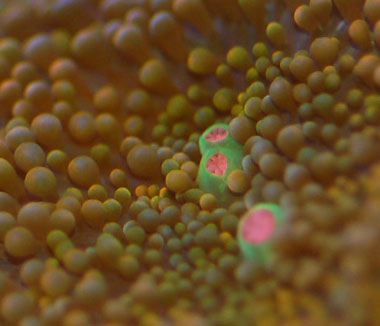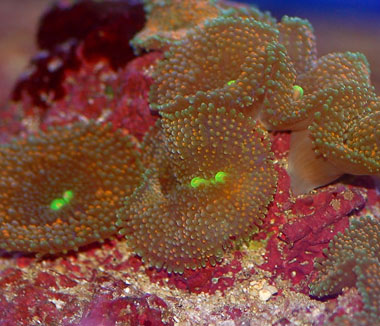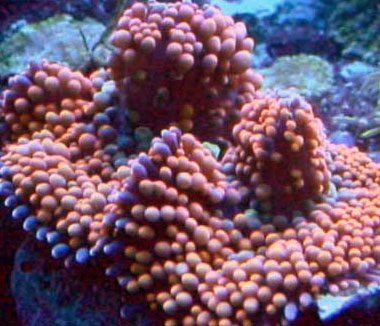|
Ricordea florida
The Corallimorpharian for Every Aquarist  Do you love corallimorpharians? If you are unfamiliar with the term, you’re not alone. Commonly known in the hobby as mushroom corals, mushroom anemones or disc anemones, corallimorpharians exist in a sort of strange taxonomic nether-region somewhere between what most aquarists think of when they think of corals and what they think of when they think of anemones. While there may be much debate about what they are, there is really no debate about the absolute suitability of these animals for the aquarium—even the beginning reef aquarist can have success with most corallimorpharians. Amongst all the corallimorpharians regularly available in the trade, it is, perhaps, the ones from the genus Ricordea that are the most interesting and desirable due to their ease of care, stunning coloration and fascinating behaviors. This article looks at one species of Ricordea—R. florida—and discusses both the animal’s traits and husbandry needs. Do you love corallimorpharians? If you are unfamiliar with the term, you’re not alone. Commonly known in the hobby as mushroom corals, mushroom anemones or disc anemones, corallimorpharians exist in a sort of strange taxonomic nether-region somewhere between what most aquarists think of when they think of corals and what they think of when they think of anemones. While there may be much debate about what they are, there is really no debate about the absolute suitability of these animals for the aquarium—even the beginning reef aquarist can have success with most corallimorpharians. Amongst all the corallimorpharians regularly available in the trade, it is, perhaps, the ones from the genus Ricordea that are the most interesting and desirable due to their ease of care, stunning coloration and fascinating behaviors. This article looks at one species of Ricordea—R. florida—and discusses both the animal’s traits and husbandry needs.
Genus Ricordea
There are two species of Ricordea that show up with frequency in the hobby—they are R. yuma and R. florida. The former is an Indo-Pacific species, while the latter—the subject of this article—is indigenous to the tropical Western Atlantic. While both are beautiful animals that adapt well to aquarium life, many aquarists are drawn to the vibrant colors of R. florida and the price, which is frequently less than R. yuma.
“Ricordea florida is one of the most desired and colorful mushroom type species found on coral reefs,” says Kris Wray, Blue Zoo Aquatics’ Collector's Choice Livestock Manager. “They come in many color variations including pinks, blues, oranges, reds, purples, and yellows—in truth, they are one of the best ways to add dramatic color with minimal upkeep to a reef aquarium.”
Taxonomy
 The genus Ricordea is one of three commonly accepted genera in the Family Corallimorphidae (ITIS), which belongs to the Order Corallimorpharia and the Subclass Hexacorallia. It’s worth drawing attention to this taxonomic structure to point out that Ricordea species are indeed hexacorals, just like anemones (Order Actiniaria), stony corals (Order Scleractinia) and zoanthids (Order Zoanthidea). The internal structure of Ricordea species is remarkably similar to the internal structure of their cousins, the stony corals, while their outward appearance closely resembles their other cousins, the anemones. This is why you may sometimes here Ricordea referred to as both “false corals” and “disc anemones.” The genus Ricordea is one of three commonly accepted genera in the Family Corallimorphidae (ITIS), which belongs to the Order Corallimorpharia and the Subclass Hexacorallia. It’s worth drawing attention to this taxonomic structure to point out that Ricordea species are indeed hexacorals, just like anemones (Order Actiniaria), stony corals (Order Scleractinia) and zoanthids (Order Zoanthidea). The internal structure of Ricordea species is remarkably similar to the internal structure of their cousins, the stony corals, while their outward appearance closely resembles their other cousins, the anemones. This is why you may sometimes here Ricordea referred to as both “false corals” and “disc anemones.”
The taxonomic classification of Ricordea is also important to the marine aquarist in terms of understanding collection impacts. The collection of Scleractinia is restricted (CITES II) in U.S. waters (including U.S. territorial waters), and while Ricordea is not a member of the Order Scleractinia as explained above, the rocks on which Ricordea grow are indeed classified as Scleractinia. As a result, the hobbyists should never see a wild collected R. florida sold on a rock larger than 2.5 cm in diameter.
Natural Habitat
In the wild, R. florida is frequently found growing in colonies that blanket rock rubble in shallow, turbid waters. They may also be found in deeper waters and as solitary animals. Growing in both horizontal (perpendicular to the seafloor) and vertical orientations, R. florida attaches itself by way of a pedal disc to just about any hard substrate.
The color of an individual specimen may be related to its natural habitat and, specifically, to the depth at which it was collected and the turbidity of the water. Individuals living in shallower water with full exposure (horizontal orientation) are frequently paler in color with shades of yellow and brown being common. Orange (and sometimes even pink) specimens may also be found in shallow water.
In the wild, R. florida is known to change colors seasonally or in response to specific events such as hurricanes.
Husbandry
As with most marine animals kept in the aquarium, a great deal can be inferred about their husbandry based on the natural habitat and understanding the animal’s innate behavior. In the following sections, this article looks specifically at placement, feeding, tankmates, and disease.
Placement
One of the reasons that Ricordea are appropriate for the beginning aquarist is that they are fairly tolerant of a wide range of lighting and flow conditions. As noted above, these animals are found in varied conditions in their natural habitat, and, so long as they are properly acclimated to the hobbyist’s aquarium, they will do well in a much wider range of aquarium conditions than many anemones and corals.
Just as in the wild, aquarium specimens will be attached to hard substrate. This is usually a small piece of rock or coral skeleton on which the animal is shipped. This rock may be placed on the bottom of the aquarium or may be glued or epoxied to the rockwork in either a horizontal or vertical position.
In short, R. florida tolerate bright reef lighting much better than most other corallimorpharians, but they also do fine in less well-lit situations such as shaded areas of the aquarium or in tanks without metal halides. Under metal halides, consider a lower, somewhat shaded or vertical placement in the aquarium. Note that such a placement may encourage the extension of the specimen’s column, which can make for a very attractive display. With less intense reef lighting, think about a shallower, horizontal placement.
As always, the aquarist should carefully observe a newly placed Ricordea specimen. If the specimen grows paler and shrinks, the lighting may be too intense. If an originally brightly colored specimen retains its size but loses some of its intensity, the lighting could probably be stronger.
At Blue Zoo Aquatics, R. florida are kept in our holding system under 400w 20k SE Ushios. Proper light acclimation is an important part of successfully introducing any hexacoral to the hobbyist’s aquarium.
In terms of aggression, Ricordea florida is a motile semi-aggressive animal. While it should be given room to grow (and should certainly NOT be placed in such a way that it will come into direct contact with other stinging-celled organisms), there is little danger to other motile invertebrates posed by Ricordea.
Ricordea florida does best with low to moderate, indirect and intermittent flow.
Feeding
 Ricordea, like all corallimorpharians, are symbiotic insofar as they rely on symbiotic zooxanthellae for food production. Having said this, it’s important to note that Ricordea are often found in shaded locations or growing in vertical orientations in their natural habitat. In fact, it is known from experience that many Ricordea specimens actually do better when not exposed directly to bright reef lighting (e.g. metal halide lights) in the aquarium. The reasons for this are not totally understood, but probably have something to do with the animal being able to rely on a combination of photosynthetic and chemosynthetic food production. Ricordea, like all corallimorpharians, are symbiotic insofar as they rely on symbiotic zooxanthellae for food production. Having said this, it’s important to note that Ricordea are often found in shaded locations or growing in vertical orientations in their natural habitat. In fact, it is known from experience that many Ricordea specimens actually do better when not exposed directly to bright reef lighting (e.g. metal halide lights) in the aquarium. The reasons for this are not totally understood, but probably have something to do with the animal being able to rely on a combination of photosynthetic and chemosynthetic food production.
In addition to photosynthetic and chemosynthetic food production, Ricordea do rely on filter feeding to a lesser or greater degree depending on the individual specimen and, more specifically, the length of the individual specimen’s tentacles. These animals are not generally well-adapted to prey capture, as can be readily gleaned by looking at the oral disc. While it is not unusual for Ricordea species to possess multiple mouths (polystomatous), the tentacles around those mouths often more resemble “bumps” than the tentacles of other filter feeding corals. Target feeding phytoplankton and zooplankton (or commercially available foods designed for filter feeding invertebrates) a couple times a week is appropriate, although, as many will state, not absolutely necessary.
Tankmates
While R. florida may well be damaged or destroyed by non-reef compatible animals, it is one of the few corals that is worth trying with some animals that are considered “reef compatible with caution.”
Disease
There are few known diseases which plague Ricordea specimens in the aquarium. Most problems are the result of inappropriate lighting or poor water conditions, although a specimen with a damaged pedal disc resulting from poor collection practices is very susceptible to bacterial infection which can cause the animal to virtually disintegrate overnight. Likewise, fragmented specimens that have not fully healed before shipping are especially vulnerable.
Supplementing trace elements can help R. florida to adapt to various lighting situations and maintain excellent health.
Propagation
Captive propagation of Ricordea florida is easily achieved by carefully cutting the individual animal in half straight through the oral disc, column and pedal disc. Care must be taken to insure that the tools used are clean so as to avoid any bacterial contamination. Propagating Ricordea in this manner is easy for the experienced hobbyists and has a very high success rate with the animals healing fully within several weeks under ideal aquarium conditions.
Conclusion
For many reasons, R. florida is an ideal aquarium animal for any reef aquarist. Hardy, beautiful and interesting, these “false corals” or “mushroom anemones” add color, variety and beauty to almost any saltwater aquarium.
“In my experience, Ricordea florida spreads faster in the aquarium than Ricordea yuma,” says Blue Zoo Aquatics Director of Marine Ornamental Research Mark Martin. “This is why I often recommend this fantastic animal for virtually any reef aquarist from beginner to expert.” He goes on to point out that R. florida is an animal with which the beginning aquarist can have success, but it is also a great animal for the advanced aquarist looking to get into coral propagation. “For the real reef geek,” Martin adds, “Ricordea florida provides an opportunity to study some of the more fascinating behaviors of these little understood corallmorphians.”
Published 8 April 2009. © Blue Zoo Aquatics
|